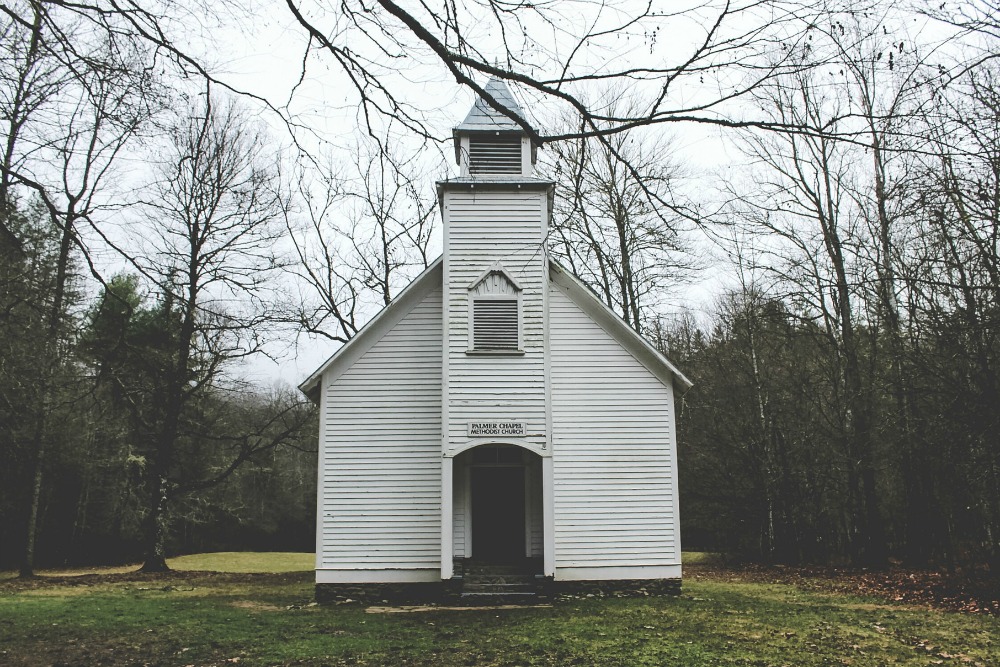This essay is part of our July series on the lives of rural Christians and the rural Church. Sam Chamelin, participant in the Collegeville Institute’s 2015 summer writing workshop Writing to Change the World with Jonathan Wilson-Hartgrove, writes about the prophetic, priestly, and pastoral role of the rural church in encouraging sustainable agriculture. To read more essays in this series, please click here.

Driving the backroads of my little piece of rural Maryland, it’s common to see a beautiful country church completely surrounded by fields of wheat, soybeans, and corn. I suspect you could call up your own image of such a church—one you could describe in great detail, perhaps tinged with powerful memories.
Yet the romanticized church in rural America is mired in precipitous decline as entire populations relocate for urban and suburban opportunities. Meanwhile, agriculture has made massive, disruptive strides towards consolidation and industrialization. Smaller parcels of land, once known as “family farms,” now hold more value to developers. Agriculture gets bigger and more efficient, while the church and the communities she serves continue to erode.
Rogation days and “Harvest Home Sundays” celebrated the work of agriculture, but they rarely included environmental and communal notes in their liturgies.
At first, it appeared that globalism and its attending economic upheaval would be good for both agriculture and the church. The move to industrial farming provided a living for many and an influx of capital found its way into rural churches. Those churches returned the favor by hosting a “blessing of the tractors,” icons of expanding scale and increasing reliance on petroleum and chemicals. Rogation days and “Harvest Home Sundays” celebrated the work of agriculture, but they rarely included environmental and communal notes in their liturgies. The methods of agricultural production were rarely addressed from pulpits, serving as a silent blessing on the industrialization happening around them.
These fundamental changes of industrialization affected not just the communities the church was called to serve, but it affected the church’s own self-understanding. Instead of the slow, local work of spiritual formation practiced in relationship, many churches moved to a programmatic approach that saw faith as a product. Congregations were judged on their programming slate and their production value. As faith, too, became a commodity, people could “shop” for a church. Language around the local church moved from “this place is my home” to “this place serves me.”
This shift was a devil’s bargain. Industrial agriculture pushed smaller farmers out of the way and churches were left to compete with one another for dwindling parishioners, raising real questions about long-term congregational vitality. Both farmers and the faithful are now looking around, wondering what happened, as the rural church loses its voice, its people, and its identity, and the farmers it used to bless are now losing their livelihood and identity as people of the land. The romantic image of the small community deeply engaged with a small church is in full-fledged descent on the backside of the bell curve. Both agriculture and the rural church are in need of a new vision of their life together.
If agriculture and religion are infected by the same virus of industrialism, perhaps they should join together to find a path to renewed health.
If agriculture and religion are infected by the same virus of industrialism, perhaps they should join together to find a path to renewed health. There is a quiet, growing movement of young, faith-filled agrarians seeking to do just that. They are moving to small parcels of land and growing food for thriving farmers’ markets, urban-based Community Supported Agricultural groups, and farm-to-table restaurants around the country. Young people are rejecting desk jobs in favor of sustainable agriculture. When you ask them about their decision they say things like, “I’m looking for a life of purpose,” or “I want to connect to something deeper.” The sustainable agriculture movement is indeed a spiritual movement, calling people to a deeper way of life.
Sustainable agriculture is an opportunity for the church. If some sectors of agriculture are asking deeper questions about their practices and returning to a slower, community-based model, religious communities would do well to bless that work. In doing so, perhaps churches can rediscover a new way of practicing faith that rejects programmatic corporatism in favor of the slow, deep work of spiritual formation. This “blessing” may take three distinctive forms modeled on the traditional threefold office of Christ.
Prophetic
Perhaps most important in this moment is the “prophetic” task. Churches cannot leave individual farmers and agricultural advocates alone, crying in the wilderness. The world has already passed several terrifying atmospheric carbon milestones; in terms of the environment, we don’t have time. What is needed is a collective voice that proclaims a preferred—a necessary— agricultural future. This prophetic task may clear the ground for sustainable agriculture, and certainly help support it.
Priestly
The church may offer a real and substantial blessing, both informally and liturgically.
Following on the prophetic task is a “priestly” one. The role of a priest, simply described, is to bless and offer sacrifice. The gospels describe Jesus’ institution of the Eucharist – he “took, blessed, broke, gave.” This is the work of the Church and it can extend to people who are doing sustainability work. The church may offer a real and substantial blessing, both informally and liturgically. By supporting sustainable agriculture and marking it with the seal of the church, rural churches may join themselves to the Kingdom that is yet to come.
Pastoral
The work of sustainable agriculture is hard and requires pastoral accompaniment. A pastor is a companion on the journey who encourages, challenges, and supports each member of the congregation as they go along their spiritual path. If regenerative agriculture is indeed rooted in spirituality, we should expect that it will generate deep questions of identity, purpose, and calling. The church must be prepared to honor that journey and join young farmers in their joys and sorrows, and to reflect on the deeper work they are doing.
Congregations are popping up all across the country to do this threefold work. My community, The Keep & Till, set out to explore agriculture as a means of renewing the church, and our mission is to make agrarian disciples of Jesus Christ who serve rural communities. We have a vision of rural renewal through regenerative agriculture and ecological conservation, all rooted in radical Christian faith.
 While we are still new at this work, we are grateful that many models of agrarian faith are available. Plainsong Farm in Grand Rapids, Michigan, is committed to growing good food and people for God. The Black Church Food Security Network, founded by Rev. Dr. Heber Brown III, is putting the land holdings of Black churches on the East Coast in service of sustainable agriculture and community development. Adamah Farm cultivates soil and soul from the Jewish tradition in service of a new world. Across the country, a growing movement of people is seeking to garden, farm, pray, and bless a new world into existence through the good news of the gospel.
While we are still new at this work, we are grateful that many models of agrarian faith are available. Plainsong Farm in Grand Rapids, Michigan, is committed to growing good food and people for God. The Black Church Food Security Network, founded by Rev. Dr. Heber Brown III, is putting the land holdings of Black churches on the East Coast in service of sustainable agriculture and community development. Adamah Farm cultivates soil and soul from the Jewish tradition in service of a new world. Across the country, a growing movement of people is seeking to garden, farm, pray, and bless a new world into existence through the good news of the gospel.
The climate and food justice movement requires communities of faith that will proclaim, bless, and support the world that yet shall be. Through this partnership the rural church may be reinvigorated, finding relevance not in programming and events, but in the real work of bringing about change to our communities through embracing a new, prophetic vision.
Like this post? Subscribe to have new posts sent to you by email the same day they are posted.



this is so interesting !sustainable agriculture and rural church can change livehood of manyand people.
want to try in India to empower the local rural churches
govt farm policy opens up the free trading and movement of farm produce any where in india .
churches are the most organised groups having plat form wit leadership
but sacred and secular divide keeps the church pastor keep them away from other aspects of transformations
unlimited scope to empower the church community and and raising support for the pastor as well if the congregation prosper the pastor as well .